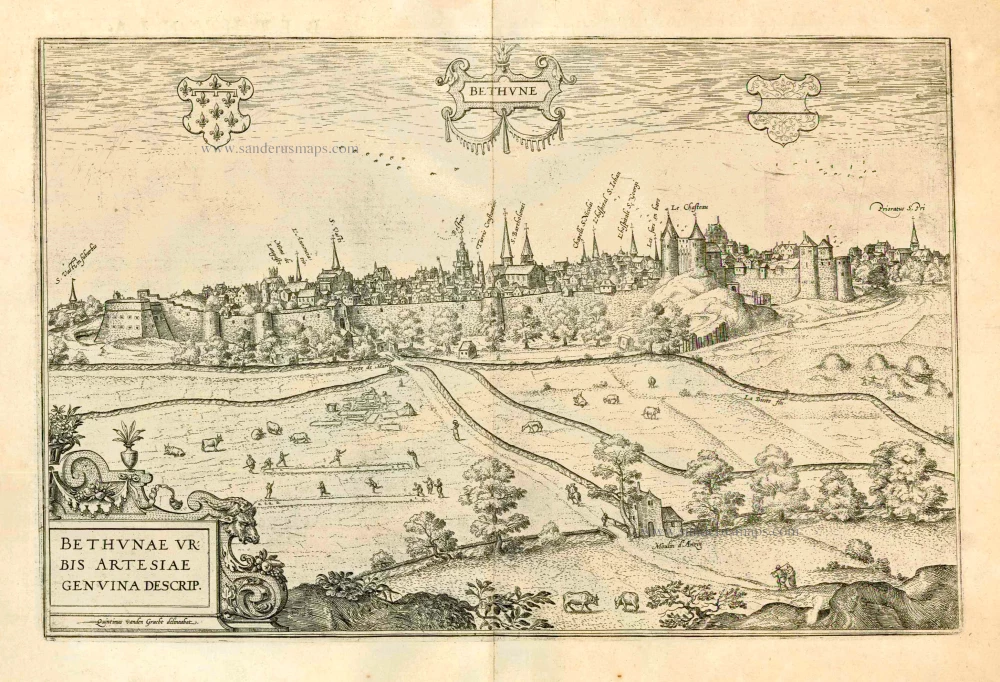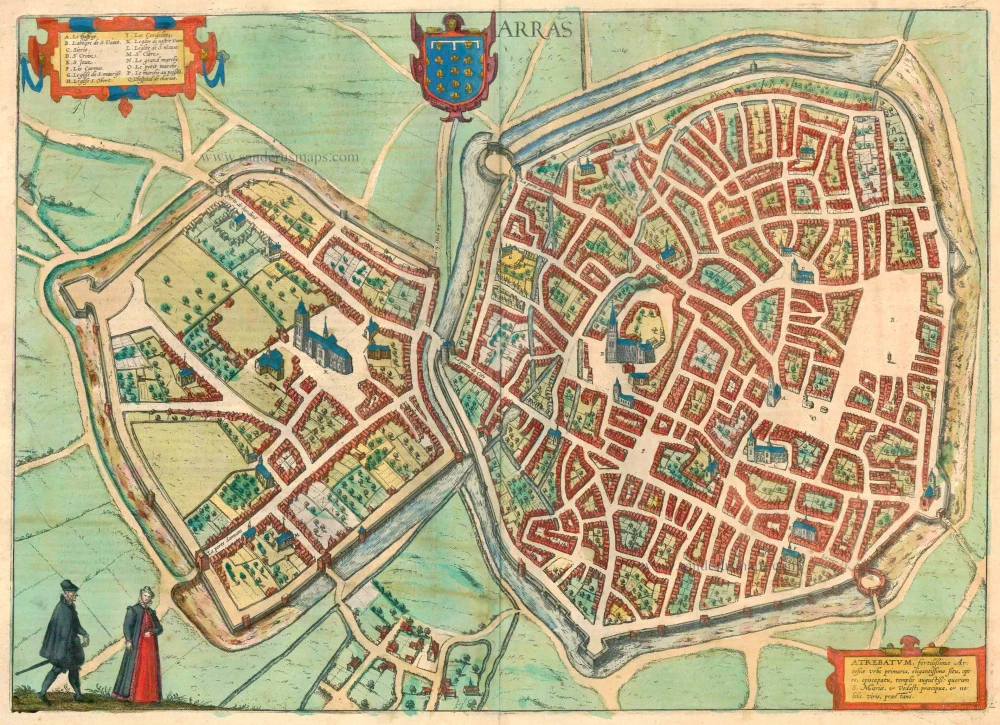Bethune, by Georg Braun and Frans Hogenberg. 1599
TRANSLATION OF CARTOUCHE TEXT: True-to-life impression of Béthune in Artois.
COMMENTARY BY BRAUN: "The little town of Béthune, also known as the granary of Artois, was formerly a famous domain of the Atrebates or Flemings, before becoming subject with others to the county of Artois [...]. The city passed to Flanders instead of Artois because it lies on this side of the Lys, which separates Flanders from Artois. Today, I believe, it ranks third among the cities of Artois, after Arras and Saint-Omer. In trade and industry, it is richly provided with grain and all the necessities of life and such things as are sold abroad."
This is a profile view from the town from the south. In the foreground are pastures and fields, crossed by streams that join up before flowing into the Lys. The peaceful countryside is animated by women laying out washing to dry and men playing boules. A wall with bastions encircles the city. Dominating features are the castle on a slight rise (right), the big church of Saint-Bartholomé in the centre and next to it on the left, the belfry, which remains the town's landmark today. The sandstone tower is today considered to be the first of its kind. The County of Artois passed to Burgundy in 1384 but fell to France again after the death of Charles the Bold in 1477. In 1493, in the Peace of Senlis, Artois was ceded to Maximilian I of Habsburg and remained in possession of the Habsburgs until the second half of the 17th century.
Braun G. & Hogenberg F. and the Civitates Orbis Terrarum.
The Civitates Orbis Terrarum, or the "Braun & Hogenberg", is a six-volume town atlas and the greatest book of town views and plans ever published: 363 engravings, sometimes beautifully coloured. It was one of the best-selling works in the last quarter of the 16th century. Georg Braun wrote the text accompanying the plans and views on the verso. A large number of the plates were engraved after the original drawings of Joris Hoefnagel (1542-1600), who was a professional artist. The first volume was published in Latin in 1572, the sixth volume in 1617. Frans Hogenberg created the tables for volumes I through IV, and Simon van den Neuwel created those for volumes V and VI. Other contributors were cartographer Daniel Freese, and Heinrich Rantzau. Works by Jacob van Deventer, Sebastian Münster, and Johannes Stumpf were also used. Translations appeared in German and French.
Following the original publication of Volume 1 of the Civitates in 1572, seven further editions of 1575, 1577, 1582, 1588, 1593, 1599 and 1612 can be identified. Vol.2, first issued in 1575, was followed by further editions in 1597 and in 1612. The next volumes appeared in 1581, 1588, 1593, 1599 and 1606. The German translation of the first volume appeared from 1574 on and the French edition from 1575 on.
Several printers were involved: Theodor Graminaeus, Heinrich von Aich, Gottfried von Kempen, Johannis Sinniger, Bertram Buchholtz and Peter von Brachel, who all worked in Cologne.
Georg Braun (1541-1622)
Georg Braun was born in Cologne in 1541. After his studies in Cologne, he entered the Jesuit Order as a novice. In 1561 he obtained his bachelor's degree and in 1562 his Magister Artium. Although he left the Jesuit Order, he studied theology, gaining a licentiate in theology.
Frans Hogenberg (1535-1590)
Frans Hogenberg was a Flemish and German painter, engraver, and mapmaker. He was born in Mechelen as the son of Nicolaas Hogenberg.
By the end of the 1560s Frans Hogenberg was employed upon Abraham Ortelius's Theatrum Orbis Terrarum, published in 1570; he is named as an engraver of numerous maps. In 1568 he was banned from Antwerp by the Duke of Alva and travelled to London, where he stayed a few years before emigrating to Cologne. There he immediately embarked on his two most important works, the Civitates published from 1572 and the Geschichtsblätter, which appeared in several series from 1569 until about 1587.
Thanks to such large scale projects as the Geschichtsblätter and the Civitates, Hogenberg's social circumstances improved with each passing year. He died as a wealthy man in Cologne in 1590.
Bethune.
Item Number: 24081 Authenticity Guarantee
Category: Antique maps > Europe > France - Cities
Old, antique panoramic view of Bethune, by Georg Braun and Frans Hogenberg.
Title: Bethune.
Date of the first edition: 1588.
Date of this map: 1599.
Copper engraving, printed on paper.
Size (not including margins): 298 x 455mm (11.73 x 17.91 inches).
Verso: Latin text.
Condition: Uncoloured, excellent.
Condition Rating: A+.
From: Liber quartus Urbium Praecipuarum totius Mundi. Cologne, Bertram Buchholtz, 1599. (Van der Krogt 4, 41:1.4(1599))
TRANSLATION OF CARTOUCHE TEXT: True-to-life impression of Béthune in Artois.
COMMENTARY BY BRAUN: "The little town of Béthune, also known as the granary of Artois, was formerly a famous domain of the Atrebates or Flemings, before becoming subject with others to the county of Artois [...]. The city passed to Flanders instead of Artois because it lies on this side of the Lys, which separates Flanders from Artois. Today, I believe, it ranks third among the cities of Artois, after Arras and Saint-Omer. In trade and industry, it is richly provided with grain and all the necessities of life and such things as are sold abroad."
This is a profile view from the town from the south. In the foreground are pastures and fields, crossed by streams that join up before flowing into the Lys. The peaceful countryside is animated by women laying out washing to dry and men playing boules. A wall with bastions encircles the city. Dominating features are the castle on a slight rise (right), the big church of Saint-Bartholomé in the centre and next to it on the left, the belfry, which remains the town's landmark today. The sandstone tower is today considered to be the first of its kind. The County of Artois passed to Burgundy in 1384 but fell to France again after the death of Charles the Bold in 1477. In 1493, in the Peace of Senlis, Artois was ceded to Maximilian I of Habsburg and remained in possession of the Habsburgs until the second half of the 17th century.
Braun G. & Hogenberg F. and the Civitates Orbis Terrarum.
The Civitates Orbis Terrarum, or the "Braun & Hogenberg", is a six-volume town atlas and the greatest book of town views and plans ever published: 363 engravings, sometimes beautifully coloured. It was one of the best-selling works in the last quarter of the 16th century. Georg Braun wrote the text accompanying the plans and views on the verso. A large number of the plates were engraved after the original drawings of Joris Hoefnagel (1542-1600), who was a professional artist. The first volume was published in Latin in 1572, the sixth volume in 1617. Frans Hogenberg created the tables for volumes I through IV, and Simon van den Neuwel created those for volumes V and VI. Other contributors were cartographer Daniel Freese, and Heinrich Rantzau. Works by Jacob van Deventer, Sebastian Münster, and Johannes Stumpf were also used. Translations appeared in German and French.
Following the original publication of Volume 1 of the Civitates in 1572, seven further editions of 1575, 1577, 1582, 1588, 1593, 1599 and 1612 can be identified. Vol.2, first issued in 1575, was followed by further editions in 1597 and in 1612. The next volumes appeared in 1581, 1588, 1593, 1599 and 1606. The German translation of the first volume appeared from 1574 on and the French edition from 1575 on.
Several printers were involved: Theodor Graminaeus, Heinrich von Aich, Gottfried von Kempen, Johannis Sinniger, Bertram Buchholtz and Peter von Brachel, who all worked in Cologne.
Georg Braun (1541-1622)
Georg Braun was born in Cologne in 1541. After his studies in Cologne, he entered the Jesuit Order as a novice. In 1561 he obtained his bachelor's degree and in 1562 his Magister Artium. Although he left the Jesuit Order, he studied theology, gaining a licentiate in theology.
Frans Hogenberg (1535-1590)
Frans Hogenberg was a Flemish and German painter, engraver, and mapmaker. He was born in Mechelen as the son of Nicolaas Hogenberg.
By the end of the 1560s Frans Hogenberg was employed upon Abraham Ortelius's Theatrum Orbis Terrarum, published in 1570; he is named as an engraver of numerous maps. In 1568 he was banned from Antwerp by the Duke of Alva and travelled to London, where he stayed a few years before emigrating to Cologne. There he immediately embarked on his two most important works, the Civitates published from 1572 and the Geschichtsblätter, which appeared in several series from 1569 until about 1587.
Thanks to such large scale projects as the Geschichtsblätter and the Civitates, Hogenberg's social circumstances improved with each passing year. He died as a wealthy man in Cologne in 1590.



